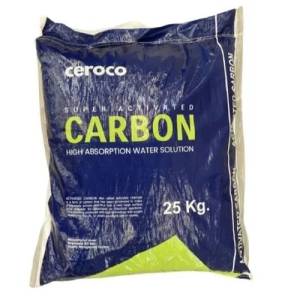Description
Activated Carbon: A Powerful Purifier
Activated carbon, also known as activated charcoal, is a versatile material with an incredibly high surface area, making it a powerful adsorbent. This means it can attract and hold a wide range of substances onto its surface, making it invaluable in various applications, from water purification to medical treatments.
What is Activated Carbon?
Activated carbon is produced from carbonaceous source materials like wood, coconut shells, coal, and peat through a process of carbonization and activation. This process creates a highly porous structure with billions of tiny pores, significantly increasing its surface area. This extensive surface area is the key to its exceptional adsorption capabilities.
Exceptional Adsorption Properties:
Activated carbon's exceptional adsorption capabilities allow it to effectively remove:
- Impurities from water: Chlorine, pesticides, herbicides, heavy metals, organic contaminants, and other undesirable substances are effectively adsorbed, leading to cleaner, safer drinking water. This is particularly useful in water filters and purification systems.
- Gases and odors: Activated carbon effectively traps and removes various gases and unpleasant odors from the air. This makes it ideal for air purification systems in homes, vehicles, and industrial settings. It's commonly used in gas masks and air filters.
- Toxins and poisons: In medical applications, activated carbon can be used to treat certain types of poisoning by adsorbing toxins from the digestive system. However, it's crucial to note that this should only be administered under strict medical supervision.
- Colors and impurities from liquids: Activated carbon is used in various industrial processes to remove unwanted colors and impurities from liquids, including pharmaceuticals, food and beverage processing, and chemical manufacturing.
Types of Activated Carbon:
The properties of activated carbon vary depending on the source material and the activation method used. Common types include:
- Powdered Activated Carbon (PAC): Used in liquid-phase applications due to its fine particle size and large surface area.
- Granular Activated Carbon (GAC): Used in both liquid and gas-phase applications due to its larger particle size and resistance to abrasion.
- Extruded Activated Carbon: Manufactured into specific shapes and sizes for enhanced performance in certain applications.
Applications:
Activated carbon finds applications in a broad range of industries and uses, including:
- Water treatment: Drinking water purification, wastewater treatment, swimming pool filtration.
- Air purification: Air filters, gas masks, odor control in vehicles and buildings.
- Medical applications: Treatment of poisoning (under medical supervision), wound care.
- Industrial processes: Chemical processing, food and beverage purification, pharmaceutical manufacturing.
- Gold recovery: Used in the extraction of gold from solutions.
Advantages of Using Activated Carbon:
- High adsorption capacity: Removes a wide range of impurities effectively.
- Cost-effective: Generally a relatively inexpensive purification method.
- Environmentally friendly: A sustainable solution compared to other purification methods in many applications.
- Versatile: Applicable to numerous industries and applications.
Note: Activated carbon is not a universal solution and its effectiveness depends on the specific application and the nature of the impurities being removed. Always follow the manufacturer's instructions and safety guidelines when using activated carbon.
